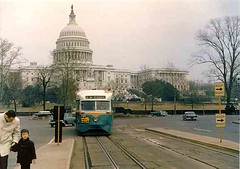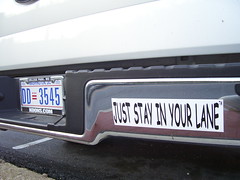Self-selection is okay even if that means not living in the city

Capital Transit 1101 on Pennsylvania Avenue, just west of Peace Monument Loop. This photo gives an excellent view of the third rail slot used to collect power in downtown Washington. Original source unknown.
In a letter today in the Post, "The most hostile place for cars," Washingtonian Jamie Rose complains about increased enforcement of parking laws and expensive gasoline bills from "sitting in downtown gridlock" and opines that increased desires to tax mean that:
By then I'll have moved to the suburbs so I can raise a family amid better schools, bigger parks, more amenities and better roads, which all our ticket dollars are supposed to be providing for us here in Washington.
Now I am the first to say that the city needs to walk on the right side of the line between delicate balance of appropriately fining people for illegal behavior, and taxing the hell out of people. You can overtax people, you can discourage people with choices from staying. Eventually, when the problems and pain in the butt aspects exceeds the benefits of staying, people leave. This is particularly pronounced with families and the quality and predictability of local schools.
But while I concede that the suburbs typically have better schools, and more shopping (retail) options, I would argue that a national class transit system with a highly functioning subway and bus system (even if typical white people seem to be averse to the bus), DC's parks, the environment for walking and bicycling, access to world class museums and libraries (National Archives, Library of Congress)--many of them free, a wide variety of free lectures, movies, concerts, and other offerings, some special amenities such as Eastern Market, the public food market, are worth living in the city for, and make living in the center city a superior choice. The quality of the roads--speaking as a bicyclist I am particularly conversant with the quality of road pavement and maintenance--isn't so bad either, comparable to the suburbs, although sure in terms of the provision of wide arterials with many many lanes, DC doesn't measure up, but I don't consider that a measure of quality necessarily.
Still, we must concede that DC isn't a perfect choice in terms of the quality of local schools and the quality of the delivery of municipal services.
But at the same time, a major problem in "city" "visioning" is the idea that the city needs to be attractive to all possible residential segments. This isn't true. Cities need to specialize and focus around urbanism, and encourage pro-urban behaviors, and discourage anti-urban behaviors.
Automobile-centricity is not to be encouraged. And it is okay if people like Jamie Rose, who prefer automobile-centricity, leave the city.
At the same time, the quality of the transit system and the ability of neighborhoods to deliver quality amenities within walking-bicycling-bus distance, in a convenient and efficient fashion, needs to continually improve, to make the need for an automobility-centric planning and development paradigm (and face it, in a planning and development paradigm of single uses spread out far and wide--typically referred to as "suburban"--a car is extremely useful to efficiently get to and from home, work, school, etc.) unnecessary.

Packard automobile ad, August 1936, featuring the U.S. Capitol in the background.
Somehow I missed this report, "Vehicle registrations drop in District," from the Examiner, about the number of automobiles registered in DC. From the article:
Vehicle registrations dropped 5.8 percent in the District between 2005 and 2008, from 258,100 vehicles to 243,200, according to the report slated to be presented Wednesday to the National Capital Region Transportation Planning Board. That drop occurred even as the D.C. population increased 1.7 percent during that time, according to U.S. Census Bureau figures.
So we have about 260,000 on-street parking spaces, a limited amount of road space (remember that cars are about 15 feet long, plus there is space in between carson the road), 248,338 households in the city and 284,221 housing units (60% are in multiunit buildings). And 400,000 people who don't live in DC travel to and from DC for work, Monday through Friday. Plus millions of people visit the city each year. Plus there are taxis, trucks and other vehicles plying the city's streets.
The city is fixed in size. It's 61 square miles of land. We can't add more land. Therefore, to get around more quickly and efficiently, we need to focus on forms of mobility that are efficient and don't require large amounts of public space (in roads and parking spaces) to serve.

Here is something I wrote about the topic in 2003, in response to the "campaign to attract 100,000 new residents to the city of Washington," that remains relevant to this discussion:
The whole point about a city, if you are truly committed to the pedestrian-based urban experience, is to not be automobile-dependent. I would never expect to be able to park in Fells Point or Little Italy (or Georgetown or Dupont Circle) on a Friday or Saturday night, unless I got there early. I would use other city-friendly forms of transportation. This leads to something that concerns me about the Mayor's campaign to attract 100,000 more residents to the City.
Obviously, attracting more residents to the city is something we need to do for many reasons -- to increase income tax revenues, to provide more residents -- eyes on the street -- to help stabilize various areas of the city, to provide more people clamoring for high-quality municipal services, etc. But I have some concerns.
.... Second, if we attract 100,000 people that want to drive and park a car everywhere, rather than walking places and/or public transportation or other forms such as bicycling, then we will be destroying the quality of life of our city. In other words, if we attract 70,000 new households with 105,000 or so more vehicles clogging our streets (especially SUVs which take up about 1.5 parking spaces compared to regularly sized cars), owned by people who believe that it is their right and privilege to drive and park their vehicles in the public space — for free — we may well ruin the character of our city. Let's not suburbanize Washington, DC!
Enhancing public transportation in all ways should be the foundation of the “City Living” campaign — enhanced bus services (including maps and marketing), the reinsertion of trolleys in major transportation corridors, continued expansion of heavy rail and the creation of “infill” stations, requiring office buildings to develop transportation demand management programs (like Arlington County), support of Metrochek, etc. -- are a piece of the puzzle.
A “transit city” must keep growing its transportation infrastructure and expanding pro-transit policies and development. If we cede the city to the car, then we will give up all that makes the city livable.
-----
From that standpoint, losing the Jamie Roses, while still working to improve public schools, the quality of municipal services, and transit, is the way to go.
It's "I love city life vs. "Just Stay in your lane."

Labels: car culture and automobility, sustainable land use and resource planning, transportation planning, urban design/placemaking



0 Comments:
Post a Comment
<< Home